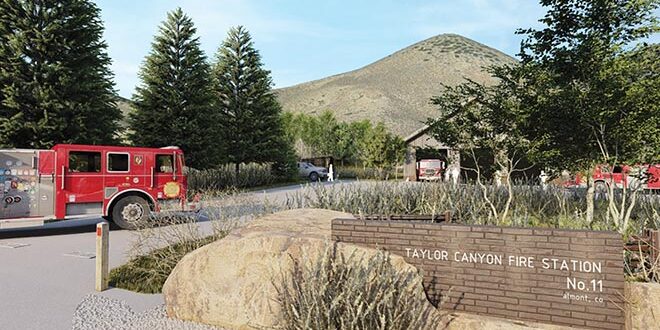Non-profit formed and construction expected to begin in June
Residents who live and own property in the Taylor Canyon, Spring Creek and Crystal Creek areas northeast of Almont are teaming up with the Gunnison County Fire Protection District to help make a fire station in their area a reality. Site and structural plans have been developed and an application for a land-use change was submitted to Gunnison County. The anticipated next steps are a public hearing and Planning Commission decision in May and a groundbreaking in June.
The proposed location of the 3,000-square-foot, three-bay facility is on County Road 742 between Jack’s Cabin Cutoff and the turnoff to Spring Creek Reservoir on land owned by Wilder on the Taylor, a historic ranch community, through a ground lease provided at no cost to the county.
Project background
Taylor Canyon Fire Station, Inc. (TCFS) was formed for this purpose and applied to the Internal Revenue Service as a non-profit 501(c)(3) organization in January 2021 and is waiting for a letter of determination. The organization was formed to construct and maintain a fire station serving the Taylor Canyon, Spring Creek and Crystal Creek areas of Gunnison County; support a volunteer fire department; and raise funds to facilitate the substation’s activities. The closest fire substation to Taylor Canyon and Spring Creek is in Almont, and the district’s main fire station is in Gunnison.
Gunnison County Fire Protection (GCFP) District’s primary revenue source is property tax. Due to Article X Section 20 of the Colorado Constitution (The Taxpayer’s Bill of Rights, a.k.a. TABOR), the district’s ability to raise revenue for funding capital expenditures is severely limited. Yet, GCFP covers a very large geographic area that encompasses portions of Gunnison and Saguache counties and does not have the funds to construct fire substations in close proximity to all remote clusters of development.
As a result, GCFP District supports the efforts of the individuals residing in these clusters to be as self-reliant as possible due to the great distances from the main firehouse in Gunnison. Groups like this have come together to establish fire departments in Pitkin, Ohio City and Sargents. “It is exciting to see areas and subdivisions taking responsibility and starting their own fire departments, like the Taylor Canyon Fire Station,” says Hugo Ferchau, fire chief for the GCFP District. “We are a big district with 2,700 square miles; to get everywhere fast just isn’t possible.”
Why a Taylor Canyon fire station is needed
The addition of the TCFS substation will provide a much quicker emergency response time to help protect the picturesque Taylor Canyon, Spring Creek and Crystal Creek areas and assist property owners in securing insurance, which has become difficult based on existing locations of current substations.
Funding and volunteer firefighters
TCFS is in the process of raising the $850,000 necessary to build the new fire substation. Those who wish to donate should go to www.taylorcanyonfirestation.org.
In tandem, GCFP District sets aside funds each year to help outlying volunteer departments to improve as first responders and to become more self-reliant in the fire management needs of their community. The district also houses firefighting apparatus at the substations for use in their operations and reimburses a portion of the operating costs based on a defined set of criteria. GCFP will provide equipment to TCFS in accordance with a memorandum of understanding executed in January 2021.
Existing volunteer firefighters can use the substations and the apparatus stored there, and additional volunteers from the Taylor Canyon and Spring Creek areas are needed. To volunteer as a firefighter, visit www.taylorcanyonfirestation.org.
Design and building
TCFS intends to commence construction of the new substation in June and is working with two Gunnison-based firms. SGM Civil and Engineering is responsible for the architecture and design of the structure, and a construction contract has been awarded to Big C Builders, with the completion timeframe expected to be 10 to 12 months, depending on weather conditions.
 The Crested Butte News Serving the Gunnison Valley since 1999
The Crested Butte News Serving the Gunnison Valley since 1999



